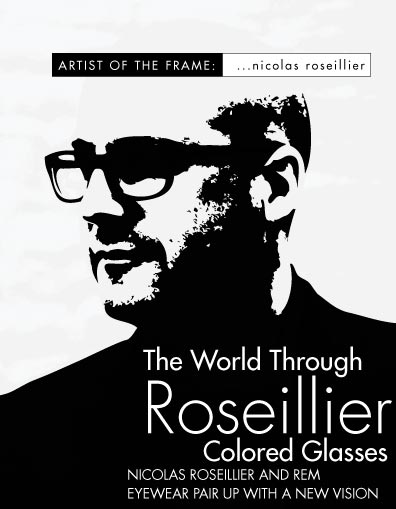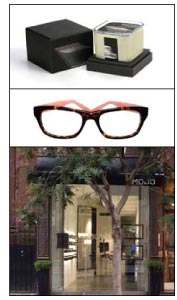
By Melissa Arkin
“When I was young, about 15 years old, I wanted to be an optician,” says Nicolas Roseillier, REM Eyewear’s new creative director. “I had a cousin who was an optician so that’s what I wanted to do. It didn’t happen. Now I’m designing glasses.”
Increasingly well-known to eyewear industry players, Roseillier has recently signed on with REM, overseeing product design and development of all brands—including the company’s luxury division, Base Curve—among these Converse, Jones New York, Lucky Brand, Barbie and John Varvatos. He brings to the table, in addition to his many design endeavors, his most recent experience as creative designer for MODO Eyewear, designing collections for the Council of Fashion Designers of America (CFDA) accessory award winner Derek Lam and 3.1 Phillip Lim. Roseillier also tackled a major rebranding effort, in addition to the opening of MODO’s first retail store in New York.
It was an unintentional trajectory of events that brought Roseillier back around to the optical industry years after his teenage interest in opticianry. “I did four years of study in technical engineering. Then I moved on to architecture and industrial design,” he says. Roseillier co-founded Les Marrons, a firm specializing in architecture and product design.
Though well-acquainted with product design, Roseillier embarked on various optical ventures before arriving at eyewear design. “It kind of happened by coincidence,” he says. “I moved to New York with my business partner at that time who I had met at school in Paris. She worked in the eyewear business in New York years before, so we opened a buisness doing projects for different eyewear companies. We designed point-of-purchase materials for Bevel Spectacle and then did some consulting for Scojo Vision, which included rebranding and redesigning packaging. Then I got a call from MODO, explaining their vision to me. I worked there for three and a half years on licenses like Phillip Lim and Derek Lam, putting them back into the high-end market.”
Roseillier’s eclectic treasure trove of talents and experiences has contributed to the artistic vision he brings to REM. But for him, eyewear design is far from one-sided; it is about collaboration, a give and take of ideas. “I didn’t approach this as, ‘What should I do for your glasses?’” he explains. “For me it’s about relationships. The relationship with a designer is really important. I want to transfer their word and their vision to the eyewear world. I want to fuse everything together.”
Establishing relationships with designers has been among the first orders of business for Roseillier as he settles into his new position. “I met with John Varvatos in his New York office and we started to really communicate. We talked a lot about architecture and music. Being able to do a men’s frame collection based on rock and roll brings a new twist. I’ve loved what he’s been doing for years. When I met with Lucky we talked about the spirit of the brand. Something quite amazing about Lucky Brand that people don’t realize is all of their designs are done by hand. They have a group of six or seven artists that paint the patterns and they’re all related to music. Then Converse—who doesn’t know Converse? It’s a classic. It’s also based on music and fun.”
Knowing not only the personality of each brand but also where it fits into the overall market is an integral part of the process. “Each brand must have its own identity, and this includes color and style, but also a real focus on positioning,” says Roseillier. “I’m involved in each step of that process—from the design of each model to the packaging and the eventual distribution. We’ve already started working on the new concepts of products.”
 When Roseillier conceptualizes his designs he dips into his everyday surroundings in his favorite cities. “I find inspiration in Tokyo and New York—amazing places with vibes you can’t find anywhere else,” he says. “I love going back to Paris, sitting on the terrace of a café and just watching people. I take different things I see everyday and add materials and techniques.”
When Roseillier conceptualizes his designs he dips into his everyday surroundings in his favorite cities. “I find inspiration in Tokyo and New York—amazing places with vibes you can’t find anywhere else,” he says. “I love going back to Paris, sitting on the terrace of a café and just watching people. I take different things I see everyday and add materials and techniques.”
With a history rich in architecture and design, Roseillier’s many influences include some iconic designers. “I started to design because at the time I was starting to do architecture, Philippe Starck was becoming very famous in France. I think design today would not be what it is if it were not for him. There are people who you may not necessarily view as mentors but who still impact your life every day. I always loved the work of [Italian modern furniture designer] Bertoia and [industrial, furniture and graphic designer] Eames.”
Whether working up designs for frames or a mapping out a blueprint, Roseillier knows meticulous attention must be paid to every aspect from start to finish. “I believe detail is what really makes a difference in eyewear,” he says. “I have an eye for detail. The fact that eyewear has become a fashion accessory means people have been expressing themselves much more. For me, I can’t do it with my haircut so I do it with my glasses.”
Achieving fashionable designs is only half the battle; Roseillier places high priority on comfort and fit, and true to his architectural training, form following function. “What’s interesting is that eyewear is the only design product you actually put on your face,” says Roseillier. “The overall picture is not just about making a pretty frame, but making sure it’s going to fit right. I want to design frames that people want to wear every day.”











